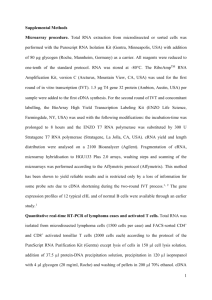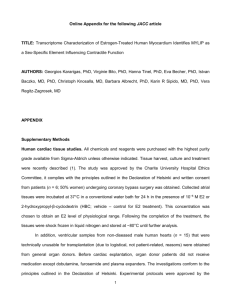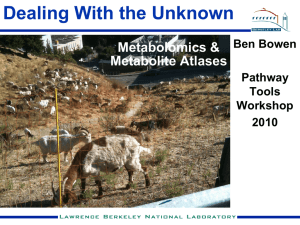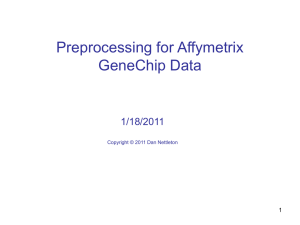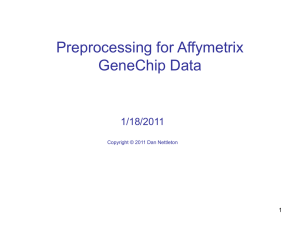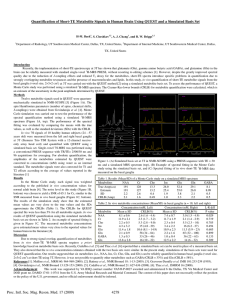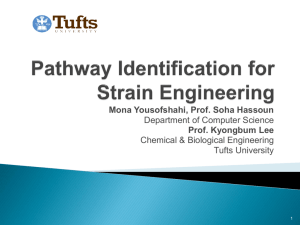TPJ_3100_sm_App
advertisement
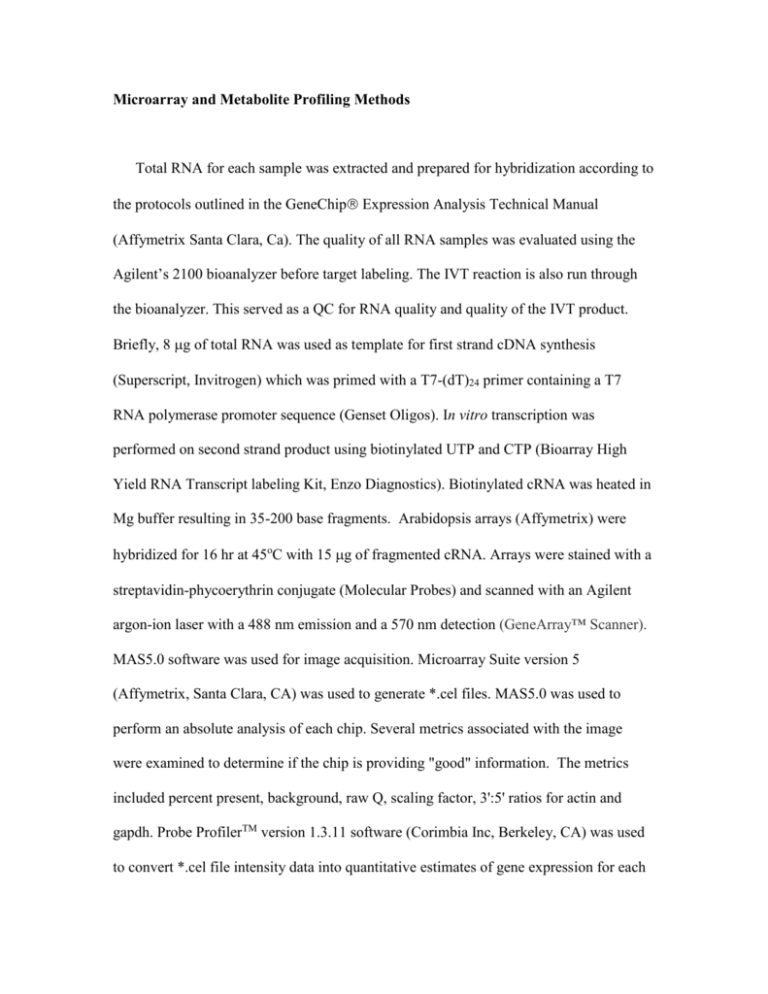
Microarray and Metabolite Profiling Methods Total RNA for each sample was extracted and prepared for hybridization according to the protocols outlined in the GeneChip Expression Analysis Technical Manual (Affymetrix Santa Clara, Ca). The quality of all RNA samples was evaluated using the Agilent’s 2100 bioanalyzer before target labeling. The IVT reaction is also run through the bioanalyzer. This served as a QC for RNA quality and quality of the IVT product. Briefly, 8 g of total RNA was used as template for first strand cDNA synthesis (Superscript, Invitrogen) which was primed with a T7-(dT)24 primer containing a T7 RNA polymerase promoter sequence (Genset Oligos). In vitro transcription was performed on second strand product using biotinylated UTP and CTP (Bioarray High Yield RNA Transcript labeling Kit, Enzo Diagnostics). Biotinylated cRNA was heated in Mg buffer resulting in 35-200 base fragments. Arabidopsis arrays (Affymetrix) were hybridized for 16 hr at 45oC with 15 g of fragmented cRNA. Arrays were stained with a streptavidin-phycoerythrin conjugate (Molecular Probes) and scanned with an Agilent argon-ion laser with a 488 nm emission and a 570 nm detection (GeneArray™ Scanner). MAS5.0 software was used for image acquisition. Microarray Suite version 5 (Affymetrix, Santa Clara, CA) was used to generate *.cel files. MAS5.0 was used to perform an absolute analysis of each chip. Several metrics associated with the image were examined to determine if the chip is providing "good" information. The metrics included percent present, background, raw Q, scaling factor, 3':5' ratios for actin and gapdh. Probe ProfilerTM version 1.3.11 software (Corimbia Inc, Berkeley, CA) was used to convert *.cel file intensity data into quantitative estimates of gene expression for each probe set. The signal values for genes with a significant treatment effect (p< .05) were normalized by performing a Z-transformation thereby generating a distribution with mean 0 and standard deviation of 1 for each gene (Draghici S. 2003. Data analysis tools for DNA microarrays. Chapman & Hill/CRC Mathematical biology and medicine series. p 466, 2003). After acquisition, all metric values must fall into acceptable ranges and within those acceptable ranges be similar. These ranges are empirical and based on previous experience. The metrics associated with the software indicate if the chips in the data set are comparable. The metrics include brightness, outliers, saturation, background, cel outliers, signal from hybridization controls and 3':5' ratios of actin and gapdh. The Probe profiler software identifies probe pairs which to not provide informative information and either eliminates the probe pair or assigns a realistic values in its place. The probe Profiler software generates a signal value for a probe set, a SD for this score assuming additive variance, an SDlog which is an estimate of the natural log, loge of the multiplicative standard deviation assuming multiplicative variance and the p-value testing the null hypothesis that the gene in this scan has an expression score greater than zero. The average intensity of the array signal values determine and then scaled to an arbitrary value (100). The data is then filtered to eliminate genes whose p-value for presence is > .05 on all chips in the experiment. The data is filtered to remove genes for which there are any missing values. The signal values for genes significantly effected by the treatment a normalized by subtracting the genes mean signal value by the SD of the genes signal value. This generates a standard normal distribution for each gene. The normalized values are run through various clustering programs (PCA & 2-way hierarchical) to determine if the treatment replication are responding similarly. Metabolite Methods Time points for metabolite profiling during cold acclimation were selected based on freeze-tolerance time-course experiments (Kaplan et al., 2004). Cold acclimation was initiated 2 h after the onset of the light period, which allowed for the harvest of all samples within the light period. Three-week-old 20°C grown plants were placed at 4°C and sampled at 1, 4, 12, 24, 48 and 96 h. Additionally, untreated controls were taken at 0 time of the experiment and 4 h after the experiment began. All samples were rapidly harvested, flash-frozen in liquid nitrogen (<30 sec), and stored at -80°C until metabolite extraction. Two sets of temperature stress experiments were performed, each comprising 2-4 replicate measurements per time point. Aerial tissues were ground in liquid nitrogen with pestle and mortar. Polar metabolites were prepared as previously described (Kaplan et al., 2004; Wagner et al., 2003). Briefly, aerial tissues were ground in liquid nitrogen with pestle and mortar. Aliquots of 60 mg frozen powder were extracted with hot MeOH/CHCl3 and the fraction of polar metabolites processed as described (Wagner et al., 2003). Ribitol, isoascorbic acid, and deuterated alanine were added as internal standards. Carbonyl moieties were protected either by methoximation or by ethoximation, using alkoxyamine hydrochloride in pyridine. Afterward, acidic protons were derivatized with N-methyl-Ntert-butyldimethylsilyltrifluoroacetamide (MTBSTFA) at 70 C or N-methyl-Ntrimethylsilyltrifluoroacetamide (MSTFA). One-microliter aliquots of these solutions were injected at a split ratio of 1:25 into a GC/MS system consisting of an AS 2000 autosampler, a GC 8000 gas chromatograph, and a Voyager quadrupole mass spectrometer including a dynode/phosphor/photomultiplier detector (all ThermoQuest, Manchester, U.K.). Mass spectra were recorded from m/z 50 to 600 at 0.5 s scan-1 for trimethylsilylated samples (TMS) and from m/z 50 to 800 at 0.7 s scan-1 for tertbutyldimethylsilylated samples (TBS). Accurate mass measurements were made using a Finnigan MAT magnetic sector field instrument (Finnigan, Bremen, Germany). Chromatography was performed using a 30 m × 250 m SPB 50 column (Supelco, Bellefonte, PA) or a 30 m × 250 m DB 5-MS column (J&W Scientific, Folsom, CA). Injection temperature was 230 C, the interface was set to 250 C, and the ion source was adjusted to 200 C. Helium flow was 1 mL min-1. After a 5-min solvent delay time at 70 C, the oven temperature was increased at 5 C min-1 to 310 C, 1 min isocratic, cool- down to 70 C, followed by an additional 5-min delay. Plant samples were derivatized and then used to confirm peak identities by comparison to reference compounds and use of the NIST, Wiley, and internally compiled spectra libraries. Retention time correction was done by internal reference compounds in order to minimize run-to-run errors. All chemicals were purchased at Sigma-Aldrich-Fluka (SAF, Deisenhofen, Germany). Stable isotope reference metabolites ([13C12]sucrose, [13C6]glucose, glycerol-d8, ethanolamined4, ethylene-d6 glycol, aspartate-d3, [13C5]glutamate, alanine-d4, valine-d8, leucine-d3 and benzoic-d5 acid) were obtained from Campro Scientific (Emmerich, Germany). Metabolite Identification GC-MS based metabolite profiling detects and quantifies specific mass spectral fragments in defined retention time windows. Identification of these fragments was performed through standard addition experiments using pure authenticated compounds to confirm identity by retention time index and mass spectrum. Compounds were designated as metabolites if they were identified with a match >750 on a scale of 0-1000 and RI deviation < 3.0. Other unidentified compounds are designated as mass spectral tags (MSTs) designated by the code NA and a unique number. In cases of high mass spectral similarity of MSTs to available commercial or custom mass spectral libraries, MSTs were named in square brackets by a preceding match value and a compound name taken from these libraries. Representative mass spectra and RI, which serve for metabolite identification in Arabidopsis thaliana, and novel identifications post publication, will be available through CSBDB (http://csbdb.mpimp-golm.mpg.de/csbdb/dbma/msri.html).



